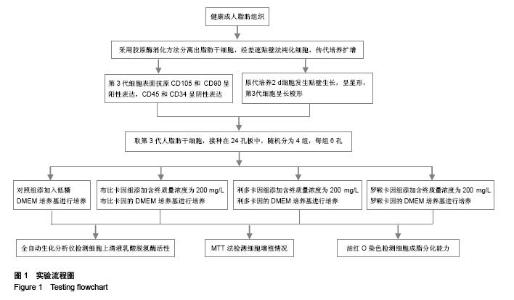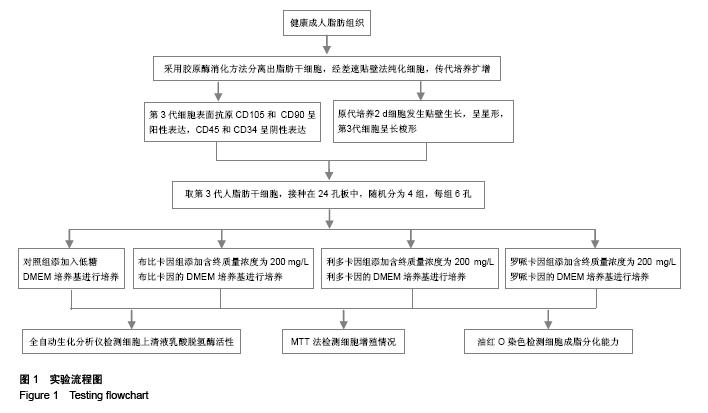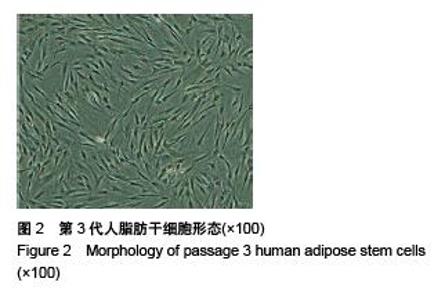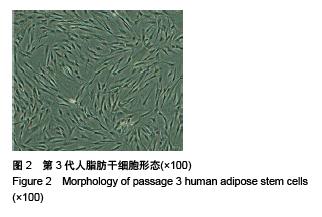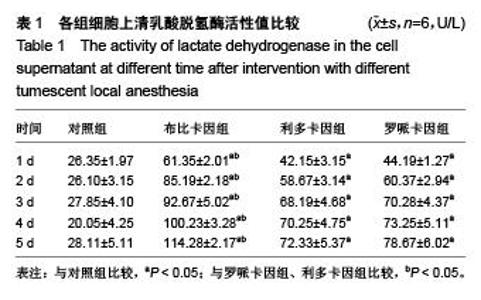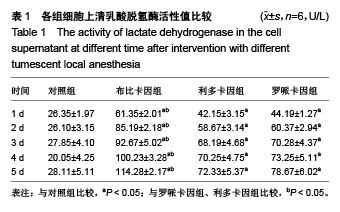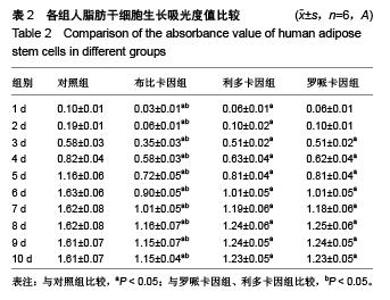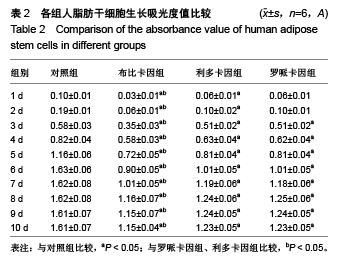Chinese Journal of Tissue Engineering Research ›› 2015, Vol. 19 ›› Issue (50): 8067-8071.doi: 10.3969/j.issn.2095-4344.2015.50.006
Previous Articles Next Articles
Effect of different tumescent local anesthesia on the proliferation and differentiation of human adipose stem cells cultured in vitro
王志刚1,吴建萍2,赵文香3
- 1Department of Anesthesiology, 2Department of Special Inspection, Binzhou People’s Hospital, Binzhou 256610, Shandong Province, China; 3Department of Anesthesiology, Binzhou Medical University Hospital, Binzhou 256603, Shandong Province, China
-
Received:2015-10-14Online:2015-12-03Published:2015-12-03 -
About author:Wang Zhi-gang, Master, Attending physician, Department of Anesthesiology, Binzhou People’s Hospital, Binzhou 256610, Shandong Province, China
CLC Number:
Cite this article
王志刚,吴建萍,赵文香. Effect of different tumescent local anesthesia on the proliferation and differentiation of human adipose stem cells cultured in vitro[J]. Chinese Journal of Tissue Engineering Research, 2015, 19(50): 8067-8071.
share this article
| [1] 刘乃军,王艳.湿性脂肪干细胞辅助自体颗粒脂肪移植术临床观察[J].中国美容医学,2012,21(15):1906-1909.[2] 黄成龙,肖金刚.脂肪干细胞成骨分化及与复合支架结合:在修复骨质疏松症骨缺损中的应用[J].中国组织工程研究,2014,18(41): 6696-6702.[3] 覃杰,闫翠,陈极锋,等.碱性成纤维生长因子对脂肪干细胞分化为心肌细胞的影响[J].中山大学学报:医学科学版,2015,36(3): 346-351,封2.[4] Shafiee A, Seyedjafari E, Soleimani M, et al. A comparison between osteogenic differentiation of human unrestricted somatic stem cells and mesenchymal stem cells from bone marrow and adipose tissue. Biotechnol Lett. 2011;33(6): 1257-1264.[5] Basu J, Genheimer CW, Guthrie KI, et al. Expansion of the human adipose-derived stromal vascular cell fraction yields a population of smooth muscle-like cells with markedly distinct phenotypic and functional properties relative to mesenchymal stem cells. Tissue Eng Part C Methods. 2011;17(8):843-860.[6] Diederichs S, Böhm S, Peterbauer A, et al. Application of different strain regimes in two-dimensional and three-dimensional adipose tissue-derived stem cell cultures induces osteogenesis: implications for bone tissue engineering. J Biomed Mater Res A. 2010;94(3):927-936.[7] Santo VE, Duarte AR, Popa EG, et al. Enhancement of osteogenic differentiation of human adipose derived stem cells by the controlled release of platelet lysates from hybrid scaffolds produced by supercritical fluid foaming. J Control Release. 2012;162(1):19-27.[8] Kang KS, Hong JM, Kang JA, et al. Osteogenic differentiation of human adipose-derived stem cells can be accelerated by controlling the frequency of continuous ultrasound. J Ultrasound Med. 2013g;32(8):1461-1470.[9] Rocha PM, Santo VE, Gomes ME, et al. Encapsulation of adipose-derived stem cells and transforming growth factor-β1 in carrageenan-based hydrogels for cartilage tissue engineering. Journal of Bioactive & Compatible Polymers. 2011; 26(5):493-507.[10] 张琳,富泽龙,冯锐,等.人脂肪干细胞复合富血小板血浆治疗裸鼠放射性皮肤损伤的实验研究[J].医学研究杂志,2015,44(7): 57-61.[11] Bourin P, Bunnell BA, Casteilla L, et al. Stromal cells from the adipose tissue-derived stromal vascular fraction and culture expanded adipose tissue-derived stromal/stem cells: a joint statement of the International Federation for Adipose Therapeutics and Science (IFATS) and the International Society for Cellular Therapy (ISCT). Cytotherapy. 2013;15(6): 641-648.[12] Song K, Wang H, Wang H, et al. Investigation of the effective action distance between hematopoietic stem/progenitor cells and human adipose-derived stem cells during their in vitro co-culture. Appl Biochem Biotechnol. 2011;165(3-4):776-784.[13] Marycz K, ?mieszek A, Grzesiak J, et al. Application of bone marrow and adipose-derived mesenchymal stem cells for testing the biocompatibility of metal-based biomaterials functionalized with ascorbic acid. Biomed Mater. 2013;8(6): 065004.[14] Scherb MB, Han SH, Courneya JP, et al. Effect of bupivacaine on cultured tenocytes. Orthopedics. 2009;32(1):26.[15] 郭晓姝,巩继平,杨根庆,等.罗哌卡因对大鼠骨髓间充质干细胞增殖和迁移能力的影响[J].中南大学学报:医学版,2013,38(11): 1152-1159.[16] Song K, Wang Z, Li W, et al. In vitro culture, determination, and directed differentiation of adult adipose-derived stem cells towards cardiomyocyte-like cells induced by angiotensin II. Appl Biochem Biotechnol. 2013;170(2):459-470.[17] Rao RR, Peterson AW, Stegemann JP. Winner for outstanding research in the Ph.D. category for the 2013 Society for Biomaterials meeting and exposition, April 10-13, 2013, Boston, Massachusetts: Osteogenic differentiation of adipose-derived and marrow-derived mesenchymal stem cells in modular protein/ceramic microbeads. J Biomed Mater Res A. 2013;101(6):1531-1538.[18] 朱艳霞,刘天庆,宋克东,等.人脂肪干细胞复合胶原/壳聚糖支架在生物反应器中扩增的研究[J].高校化学工程学报,2010,24(2): 239-246.[19] 崔磊,尹烁,杨平,等.脂肪干细胞HLA分子表达与体外抑制淋巴细胞增殖的实验研究[J].中华医学杂志,2005,85(27):1890-1894.[20] Wang X, Mäkitie AA, Paloheimo KS, et al. Characterization of a PLGA sandwiched cell/fibrin tubular construct and induction of the adipose derived stem cells into smooth muscle cells[J]. Materials Science & Engineering C. 2011; 31(31):801-808.[21] Ma J, Both SK, Ji W, et al. Adipose tissue-derived mesenchymal stem cells as monocultures or cocultures with human umbilical vein endothelial cells: performance in vitro and in rat cranial defects. J Biomed Mater Res A. 2014;102(4): 1026-1036.[22] 马德彰,李鹏,刘明,等.富血小板血浆和线性高密度聚乙烯支架材料对大鼠脂肪干细胞成骨分化的影响[J].中华实验外科杂志, 2013,30(11):2371-2373.[23] 余方圆,卢世璧,袁玫,等.脂肪干细胞向软骨细胞方向诱导的初步研究[J].中国矫形外科杂志,2004,12(10):762-764.[24] Komatsu I, Yang J, Zhang Y, et al. Interstitial engraftment of adipose-derived stem cells into an acellular dermal matrix results in improved inward angiogenesis and tissue incorporation J Biomed Mater Res A. 2013;101(10): 2939-2947.[25] 梁桦.七氟醚对人肺腺癌A549细胞生长、转移能力及化疗敏感性的影响[D].广州:南方医科大学,2012.[26] 赵曦.七氟烷预处理对骨髓间充质干细胞在缺氧复氧环境下增殖和凋亡的影响[D].沈阳:中国医科大学,2014.[27] 任军,徐礼鲜.异氟醚对人口腔癌细胞系生物学特性影响的实验研究[C].全国第三次麻醉药理学术会议论文集,2012:236-239.[28] 王浩,仓静,薛张纲,等.异丙酚对体外培养大鼠神经干细胞增殖的影响[J].中国临床医学,2011,18(2):222-225.[29] 王浩.异丙酚对肝细胞凋亡及神经干细胞增殖的作用及其分子机制研究[D].上海:复旦大学,2009. |
| [1] | Jiang Tao, Ma Lei, Li Zhiqiang, Shou Xi, Duan Mingjun, Wu Shuo, Ma Chuang, Wei Qin. Platelet-derived growth factor BB induces bone marrow mesenchymal stem cells to differentiate into vascular endothelial cells [J]. Chinese Journal of Tissue Engineering Research, 2021, 25(25): 3937-3942. |
| [2] | Chen Yang, Huang Denggao, Gao Yuanhui, Wang Shunlan, Cao Hui, Zheng Linlin, He Haowei, Luo Siqin, Xiao Jingchuan, Zhang Yingai, Zhang Shufang. Low-intensity pulsed ultrasound promotes the proliferation and adhesion of human adipose-derived mesenchymal stem cells [J]. Chinese Journal of Tissue Engineering Research, 2021, 25(25): 3949-3955. |
| [3] | Zhang Lishu, Liu Anqi, He Xiaoning, Jin Yan, Li Bei, Jin Fang. Alpl gene affects the therapeutic effect of bone marrow mesenchymal stem cells on ulcerative colitis [J]. Chinese Journal of Tissue Engineering Research, 2021, 25(25): 3970-3975. |
| [4] | Ruan Guangping, Yao Xiang, Liu-Gao Miyang, Cai Xuemin, Li Zian, Pang Rongqing, Wang Jinxiang, Pan Xinghua. Umbilical cord mesenchymal stem cell transplantation for traumatic systemic inflammatory response syndrome in tree shrews [J]. Chinese Journal of Tissue Engineering Research, 2021, 25(25): 3994-4000. |
| [5] | Mo Jianling, He Shaoru, Feng Bowen, Jian Minqiao, Zhang Xiaohui, Liu Caisheng, Liang Yijing, Liu Yumei, Chen Liang, Zhou Haiyu, Liu Yanhui. Forming prevascularized cell sheets and the expression of angiogenesis-related factors [J]. Chinese Journal of Tissue Engineering Research, 2021, 25(22): 3479-3486. |
| [6] | Chen Lei, Zheng Rui, Jie Yongsheng, Qi Hui, Sun Lei, Shu Xiong. In vitro evaluation of adipose-derived stromal vascular fraction combined with osteochondral integrated scaffold [J]. Chinese Journal of Tissue Engineering Research, 2021, 25(22): 3487-3492. |
| [7] | Wei Qin, Zhang Xue, Ma Lei, Li Zhiqiang, Shou Xi, Duan Mingjun, Wu Shuo, Jia Qiyu, Ma Chuang. Platelet-derived growth factor-BB induces the differentiation of rat bone marrow mesenchymal stem cells into osteoblasts [J]. Chinese Journal of Tissue Engineering Research, 2021, 25(19): 2953-2957. |
| [8] | Chen Xiao, Guo Zhi, Chen Lina, Liu Xuanyong, Zhang Yihuizhi, Li Xumian, Wang Yueqiao, Wei Liya, Xie Jing, Lin Li. Factors affecting the mobilization and collection of autologous peripheral blood hematopoietic stem cells [J]. Chinese Journal of Tissue Engineering Research, 2021, 25(19): 2958-2962. |
| [9] | Guo Zhibin, Wu Chunfang, Liu Zihong, Zhang Yuying, Chi Bojing, Wang Bao, Ma Chao, Zhang Guobin, Tian Faming. Simvastatin stimulates osteogenic differentiation of bone marrow mesenchymal stem cells [J]. Chinese Journal of Tissue Engineering Research, 2021, 25(19): 2963-2968. |
| [10] | Li Congcong, Yao Nan, Huang Dane, Song Min, Peng Sha, Li Anan, Lu Chao, Liu Wengang. Identification and chondrogenic differentiation of human infrapatellar fat pad derived stem cells [J]. Chinese Journal of Tissue Engineering Research, 2021, 25(19): 2976-2981. |
| [11] | Gao Yuanhui, Xiang Yang, Cao Hui, Wang Shunlan, Zheng Linlin, He Haowei, Zhang Yingai, Zhang Shufang, Huang Denggao. Comparison of biological characteristics of adipose derived mesenchymal stem cells in Wuzhishan inbreed miniature pigs aged two different months [J]. Chinese Journal of Tissue Engineering Research, 2021, 25(19): 2988-2993. |
| [12] | Cao Yang, Zhang Junping, Peng Li, Ding Yi, Li Guanghui. Isolation and culture of rabbit aortic endothelial cells and biological characteristics [J]. Chinese Journal of Tissue Engineering Research, 2021, 25(19): 3000-3003. |
| [13] | Dai Min, Wang Shuai, Zhang Nini, Huang Guilin, Yu Limei, Hu Xiaohua, Yi Jie, Yao Li, Zhang Ligang. Biological characteristics of hypoxic preconditioned human amniotic mesenchymal stem cells [J]. Chinese Journal of Tissue Engineering Research, 2021, 25(19): 3004-3008. |
| [14] | Qin Yanchun, Rong Zhen, Jiang Ruiyuan, Fu Bin, Hong Xiaohua, Mo Chunmei. Chinese medicine compound preparation inhibits proliferation of CD133+ liver cancer stem cells and the expression of stemness transcription factors [J]. Chinese Journal of Tissue Engineering Research, 2021, 25(19): 3016-3023. |
| [15] | Dai Yaling, Chen Lewen, He Xiaojun, Lin Huawei, Jia Weiwei, Chen Lidian, Tao Jing, Liu Weilin. Construction of miR-146b overexpression lentiviral vector and the effect on the proliferation of hippocampal neural stem cells [J]. Chinese Journal of Tissue Engineering Research, 2021, 25(19): 3024-3030. |
| Viewed | ||||||
|
Full text |
|
|||||
|
Abstract |
|
|||||
